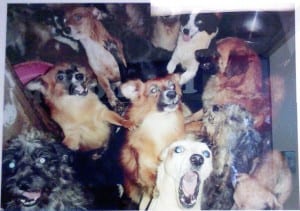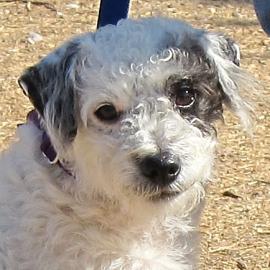So since it’s now been forever since I did an update, and since I apparently still can’t think of anything to write about diet, training, etc. I figured I’d do an update on my time at the Austin Humane Shelter. I’ve now been there a full year and a half (I started in November of 2010 as I was crawling out of my depression, as I detailed in Volunteering at the Austin Humane Shelter series) and quite a bit has happened since then.
I’ll be mainly focusing on 2011 since, frankly, last year was crazy almost from start to finish. Actually, it wasn’t crazy, it was pretty much a disaster. Things started off quietly enough, the first couple of months were just normal times at the shelter. I was deep into my winter training grind and volunteering regularly. We pick up in Februrary, 2011.
Working Blue
By the time I had been at the shelter for four months, I have moved from a newbie Green BRATT through Blue Dot and then had taken a special full blue BRATT class (that was put together for 5 of us who had forgotten to get into the main class). It was five classes across 6 weeks and, at this point, we were into full on dog training. As a reminder (or for folks who didn’t or don’t want to read the original series), the Austin Humane Shelter dog volunteer program uses a color system to ‘rank’ the dogs.
Similarly, dog walkers (called BRATT’s which stands for Behavioral Rehoming Assessment Training Team; a description of what we do) are ranked by color and you can only walk dogs at your color level and below. There are are a number of reasons for this (ranging from safety to consistent training) but the color levels mainly rank the dogs on what type of general behaviors you can expect. In order from easiest to hardest:
- Green dogs are the easiest, with zero behavioral problems; they can be walked by anyone.
- Blue dot dogs may have a single minor behavioral issue. It may something as simple as they are difficult to get in or out of their kennel or something else. Basically if they can’t be walked by anyone at the shelter but have no major issues, they will be blue dot.
- BB dogs (think of it as blue extreme) may have multiple minor behavioral issues or one or two larger issues. This can be persistent pulling, dog reactivity, a lack of attention to handlers or a few others. By the time you take the full blue class, you have undergone a good bit of basic dog training so that you can not only handle such dogs but are able to start training them (which makes them more adoptable).
- Yellow dogs can vary quite a bit, some may be shy as hell, others can get easily overaroused, leash bite, engage in a variety of dominance behaviors (such as height seeking), etc. They are more unpredictable, running the gamut from perfect and easy to handle to just going nuts at the flip of a switch.
- Orange dogs are the most extreme in terms of behavior and may show a multitude of behavioral issues or one or two at an extreme level. Orange volunteers have undergone extensive training (including a full one year internship to move to Orange level) to be able to work with those dogs.
- I’d note that there are two other color markings which are purple (for puppies) and red (for sick or staff only dogs) but this has little to do with behavior.
So as a full blue BRATT, I was now working with the BB and lower dogs. That generally meant focusing my time and energy on the BB dogs and only walking blue dot or green dogs when I had gotten all of the higher levels dogs taken care of or there were no lower level volunteers (as much as possible you try to leave lower level dogs for lower level volunteers so that they have something to do and can get experience with the animals). I was also being exposed to other things such as doing walks around the block with a Yellow BRATT, or helping with the occasional playgroup.
This was also when I started helping with 1:1 training for new volunteers. This is expected of blue BRATTs and I was happy to do it. My schedule is flexible as hell so I was always able to cover times that nobody else could when new volunteers had limited times or whatever to get trained. And given what the shelter had given (and was still giving) to me, it was important to me that I pass it on to new volunteers to get them involved in our program. The volunteer who originally trained me is still at the shelter; she can either be thanked or blamed for my nearly chronic presence at the shelter.
Frankly, I had tons to do since the majority of the dogs at the shelter tend to be blue dot or BB. It was a rare day indeed that I wasn’t able to fill three full hours walking and training nothing but BB dogs with the normal shelter population. I was also using what I had learned in class to train ALFIE (who had been a BB dog when I adopted him) so it was all good. And this would go on for the first few months of the year; sadly, it was the quiet before the storm and shit was about to go nuts.
May: Hoarders Dog Edition
As I mentioned in the original series, the Austin Humane Shelter volunteer program has it’s own Yahoo group and mailing list that sends out announcements about all kinds of stuff. It keeps everyone in the loop, let’s us communicate about dog behavior, see special announcements, know when shifts need extra coverage, etc.
And one weekend in the digest I saw a huge call for volunteers, something had happened and the shelter was about to take in a ton of dogs and they needed all hands on deck. I had no idea but headed in that Saturday. And the shelter looked like a disaster area. But I’m getting ahead of myself.
So at some point, I’m guessing in 2009 or 2010, a woman in Bastrop (a boondock area outside of Austin), maybe it was earlier, had decided to start ‘saving’ dogs and cats. And she just kept collecting them and collecting them. Until the animals took over her house, started interbreeding and multiplying. She had moved into the outside shed and just given them the run of it. And while I’m a bit unclear on how this all went down, the Bastrop fire department went to her house, opened the door and this is what they saw.
.

.
Yeah, like the pit of hell. There were one hundred some odd dogs and I don’t know how many cats, all living in their own food and filth in this woman’s house. They had been inbreeding with one another (and a few of them were clearly mentally impaired or had physical defects) and, well…just look at the picture above. And we took all of them in. I mean every single dog and cat. Now, normally the shelter dog population is maybe 50-60 dogs. And when we are full it’s hard enough to get all the dogs taken care of in a single shift.
Now nearly quadruple that. That’s what we were facing. Every possible space was taken by dogs, dogs and more dogs. Hell, rooms I’d never even been in before were being used to house animals. We had makeshift kennels and crates everywhere and 2-3 dogs to each kennel. It’s a really good thing that the grand majority of the dogs were small or I don’t see how we could have housed them. But, it was simply nuts.
And none of these dogs had even been on a leash, or worn a collar. Mind you, they were ridiculously well behaved given the circumstances but I guess when you have 170 dogs living in close quarters, that tends to breed politeness: any dog who acted out probably got his ass kicked. I have to think, in hindsight, that if any had had behavioral issues we would have been totally overwhelmed.
And like I said they were all in just horrible condition. Filthy matted fur, never groomed, covered in poop and piss. Groomers were working overtime showering and cleaning and just shaving them down. The transitions are shocking, here are two before and after pictures to give you some perspective on this; it doesn’t even look like the same dog.
.


And we had to take care of all of them. But cleanup was just the start of the work. Like I said, they had never been on collars or leashes and we had to teach them how to wear/walk on them and that took time. That was on top of pottying them all and trying to socialize them somewhat. So for weeks stretching into months, it was just this exhausting grind of taking 2-3 dogs (often just carrying an armful) to the runs to potty these dogs and try to get them used to being dogs.
Mind you, the volunteers came out in droves to help with grooming and cleaning and everything else. So did the Austin population in general, a huge number of dogs were taken into foster just to clear up space in the kennels and get some of the dogs into a lower stress situation.
And this went on for months as we tried to deal with them, get them cleaned and basically trained, get them adopted. It was exhausting, with little to no time to do anything but just run dogs to potty and back. A lot of volunteers burned out and so far as I can tell a fair few left the program because they were just exhausted.
This isn’t uncommon, folks who have that ‘caretaker’ type of personality profile often forget that their own health and well being is just as important. They feel the need to save everyone and end up burning themselves out; then they are no good to anybody.
In any case, after the dogs had been cleaned and groomed and everything else we held a massive adoption event. Apparently over 1000 people came out, standing in the hot Austin sun for up to 2 hours to get a chance at the dogs. And we got most, if not all of them, adopted. Snickers, a dog that had been clearly inbred (he was scruffy in just the right kind of way but wasn’t all there, if you get my drift) was one of the last to go. I remember because I spent a lot of time with him for some reason.

In any case, if you want to see more of what the whole mess looked like, here’s a four minute video. You can see what the shelter looked like at about the 1 minute mark.
.
And, finally, after what seemed like forever, things settled down. And since the dogs never stop coming, it wasn’t as if everyone got to take a well deserved break after the months of craziness. As soon as they are emptied, the kennels fill back up with dogs and it was back to a more or less ‘normal’ day to day volunteer existence. And we had what I seem to recall was two to three weeks of relatively normalcy before the next disaster hit.
Read Volunteering at the Austin Humane Shelter: Part 7.
Similar Posts:
- AHS
- People Do It Because We Let Them
- The Real Benefits of High Frequency Training
- People Do It Because We Let Them: Part 3
- Bipolar Recovery Update 7
Welcome back…
Lyle,
Thanks for this, I really enjoyed the read, I think that in the world of health and fitness where you contribute a lot of extremely useful information, the audience who read the information “may in part” be driven primarily by vanity and self-interest and OCD tendencies. The “here is my sixpack and striations and because I am more ripped than you and stronger than you, I am superior to you” etc. (NB – I don’t put myself above any of these tendencies). An interesting cohort of humans indeed!!!
When I was doing my honours degree in psychology, I volunteered at a therapeutic community (long term residential for drug and alcohol addiction) out of self-interest to develop skills and learn more, and also to assist people’s recovery (more altruistic) . I found this one of the most meaningful things I have ever done in my life, because it was not wedded to earning money, and I could leave at anytime. I hung in week in week out and felt that I offered so value for once.
Seems as though contributing and volunteer work has its own and unique rewards. As a dog lover, who incidentally was savaged really badly as a kid by a dog and almost lost the sight of one eye, I have grown up and lived with dogs all my life. Nothing better than dogs for company at times, they want so little and offer so much. Maybe we in the fitness industry could really learn a lot from them.
Thanks again – Paul D
Wow. Great to have you back Lyle. That’s quite a story. The condition of the dogs is repulsive. It’s a shame that she probably believed she was helping them. Hoarding is almost always a sign of severe depression / anxiety issues.
I’ve long been crossing my fingers for a full scale series on specialization from you for a long times. You’ve hinted at it a few times. Just in case you’re looking for ideas on training topics.
Hope your time away from the blog was spent well and best to you and the humane society. My two cats are from the Miami Humane society, and I am thankful for the people that volunteer and help out there everyday.
Wow. I thought you were being facetious with your title, but animal hoarding is an actual TV show. I live in a wealthy suburb with 2-3 acre lots that back to farmland, and in the last year we’ve had two difficult neighbors move in next door to each other. Neither family has a large number of dogs – 3 each – though the second one has goats, horse and who knows what else – but the dogs are unleashed, have followed me on my runs and are leaving messes on other lawns and the street. Everyone I know has simply stopped walking past their houses, and the other day I saw a hapless stranger trying to return the young pit bull to the wrong house. None of the regular walkers has seen either house walk the dogs. We’ve been talking about having some kind of sit-down with them about the existing dogs, I certainly hope this is not the beginning of an animal hoarding.